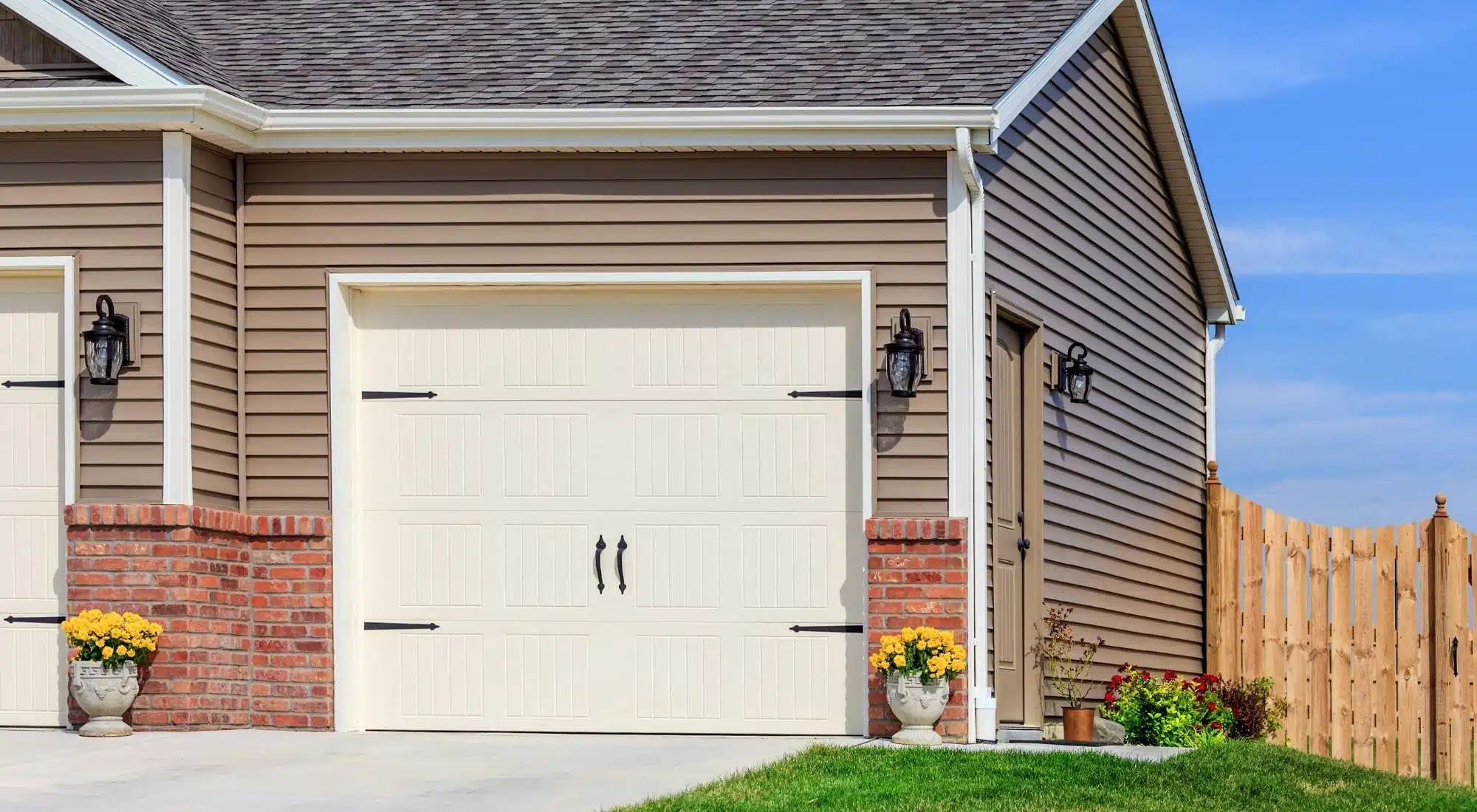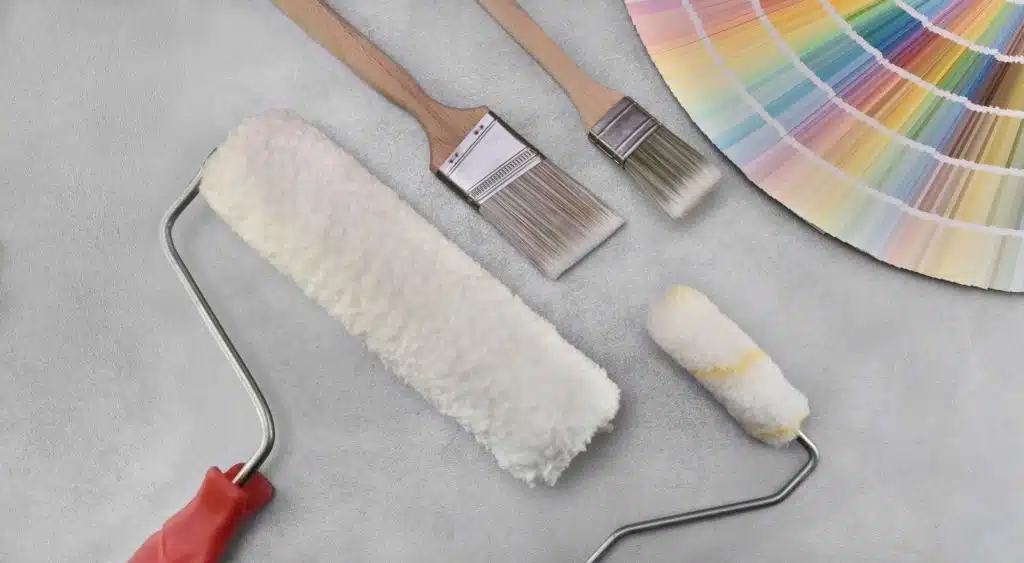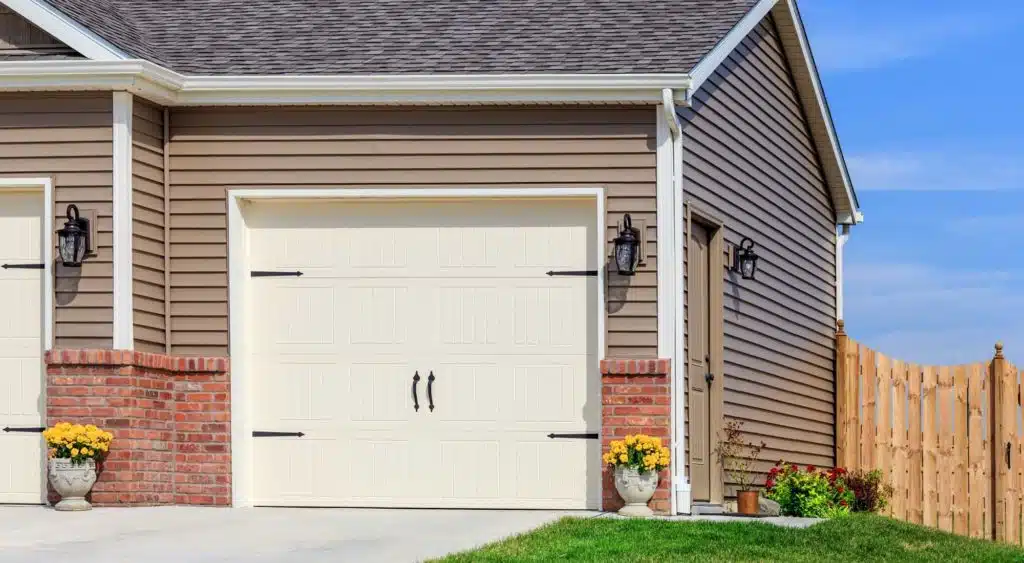Has your front door taken a beating from Mother Nature? Has your vinyl garage door seen better days?
It sounds like it is time to break out the paint and brushes and give them a much-needed facelift!
We know you are ready to paint, but before dipping your paintbrush into the paint, you must research and learn what to do.
Without preparation, painting a vinyl door can quickly become overwhelming. In contrast to bare steel, a vinyl coating gives a steel door rust and corrosion resistance. This makes the door far more resistant to corrosive elements but also makes painting it difficult.
Keep reading because, in this article, you will learn:
- Can you paint vinyl doors?
- The best paint for vinyl doors
- How to prepare a vinyl door for painting;
- And much more
Table of Contents
- Can You Paint Vinyl Doors?
- Why You Might Want to Paint Vinyl Doors?
- What Kind of Paint Do You Use on Vinyl Doors?
- 3 Best Paints for Vinyl Doors
- How Do You Prepare a Vinyl Door for Painting?
- How to Paint a Vinyl Door: 6 Steps for a Complete Project
- Two Brothers Painting: Offering Professional Painting for Vinyl Doors in the Portland Metro Area
Can You Paint Vinyl Doors?
Yes, vinyl doors can be painted, but some prep work is involved.
Why You Might Want to Paint Vinyl Doors
Eventually, exterior vinyl doors may start to look tired, so you may want to paint them rather than replace them.
Additionally, any place with high moisture content, typically in commercial buildings, such as bathrooms or locker rooms, may need a renovation or touch-up from time to time.
What Kind of Paint Do You Use on Vinyl Doors?
Acrylic works best. Oil-based paint is an acceptable option, too, but it can be challenging to find.
If you use anything other than these three, the vinyl may warp, and the paint will melt once it’s too hot.
3 Best Paints for Vinyl Doors
Acrylic Paint
Acrylic paint’s consistency is thick and water-based. As a result of its lightweight consistency, acrylic paint adheres tightly to vinyl surfaces and is very durable.
Additionally, acrylic paint dries very quickly.
It’s essential to be aware that since acrylic paint is fast-drying, if you have a spill or get paint on your clothing, there’s a good chance that it will be there for the long haul.
Latex Paint
In addition to acrylic paint, latex paint can also be used, but it may not adhere as well as acrylic paint.
However, latex paint:
- Emits less odor
- Is easier to clean with soap and water; and
- Is less prone to fading
Overall, when compared to other types of paint, latex paint is not as durable, and it can be difficult to achieve a smooth finish.
Oil-Based Paint
Oil-based paints contain natural oils such as alkyd and linseed. The texture of oil-based paint is generally smooth and glossy when applied.
Furthermore, oil-based paint is:
- Durable
- Resistant to stains and scratches; and
- Provides excellent coverage
There are several pros to oil-based paints, but be aware that out of all the paints we’ve discussed, oil-based paint takes the longest to dry and has become challenging to find.
Is your home’s front door in need of a facelift? Is it time to refresh the paint?
Two Brothers Painting is a family-operated home painting business equipped to tackle the job of painting the exterior of your home — and any vinyl doors your home might have.
Please feel free to contact us today!
How Do You Prepare a Vinyl Door for Painting?
To prepare a vinyl door for painting:
- Rinse the door with a hose to remove dirt and debris.
- Remove the door from its hinges and lay it flat on a drop cloth.
- Remove the door handle.
You’ll also need to make sure you have a few supplies, such as:
- Cleaning supplies
- Sealant
- Sandpaper
- Degreaser
- Roller; and
- Paintbrush
How to Paint a Vinyl Door: 6 Steps for a Complete Project
Step #1: Clean
Cleaning the door thoroughly before painting will help the paint adhere better. A soap and water solution can be used to clean vinyl-coated doors. Be sure to use a soap that is specifically designed for vinyl surfaces.
Then, using a sponge, apply the soap and water solution to the door and rub vigorously to remove:
- Dirt
- Grime; and
- Grease
Allow the door to dry thoroughly after rinsing with fresh water.
It’s essential to ensure no soap residue is left behind — dirt and slippery soap do not allow the paint to stick!
Step #2: Sand
Before painting, you should sand the door’s surface to smooth out any unevenness. By sanding, you’ll be planning ahead — sanding helps smooth out the paint’s finish.
By sanding the door, you will help create a better surface for …
- Primers
- Paints; and
- Stains
… to adhere to.
Using fine-grit sandpaper, sand with light pressure and then increase the pressure while moving the sandpaper or sander in a circular motion.
After you’ve sanded the surface, check for flaws. There may be some parts that need to be sanded again.
Once you have double-checked the door, wipe it down with a damp cloth to remove any dust. If the door needs a deep cleaning, use a vacuum.
When sanding a vinyl door, you should protect your skin by wearing a dust mask and goggles.
Any exterior painting job can become complicated. Are you overwhelmed by the thought of it?
The experts at Two Brothers Painting have over 145 years of combined experience.
Our goal is to treat our customers as we would like to be treated, and we paint their homes as if they were our own.
Schedule your estimate today.
Step #3: Prime
Painting vinyl doors without primer is one of the most common mistakes people make. A primer is necessary to ensure that the paint adheres to the surface properly and does not peel off.
Primers for vinyl doors come in various types, but acrylic primers are the most common and recommended. This primer will create a smooth surface for painting and prevent the paint from peeling or flaking off.
The initial coating is key to a successful paint job for a vinyl-coated door. The first coat must be a primer coat that will adhere to the vinyl and allow you to paint a finishing coat on the door with the color of your choice.
Priming a vinyl door involves the following steps:
- Stir the primer — To ensure proper application, mix the primer thoroughly.
- Test the Primer — The primer will adhere directly to most correctly prepared doors; however, it is best to test this first on a corner to see if it flakes or peels after it dries. You can score the vinyl-coated door with 200-grit sandpaper if the adhesion between the primer and vinyl is not acceptable. Sanded surfaces should be wiped clean with a damp cloth and allowed to dry before continuing.
-
- Paint the Door With Primer — Depending on your door size, you can brush or roll on the primer. It is best to brush over patterns on the door, so every inch is covered.
- Allow the primer to dry — It’s essential not to attempt to degloss over the wet primer.
Step #4: Degloss
Once you have primed, it’s time to move on to deglossing. Using a deglosser (aka “chemical sander”) helps dull any shininess, which will help create a mechanical bond with the paint.
Following are the steps to degloss a vinyl door:
- Protect your skin and eyes from the drying effects of the chemical sander by wearing heavy gloves and chemical-resistant eye goggles.
- Put a small amount of chemical sander in a large metal or glass container to hold the paintbrush.
- Use a disposable paint brush to apply the deglosser to the surface. Once it has been set for five minutes, wipe it off with a clean cloth to remove any dust or oil. Go back in two hours, and wipe the surface with a tack cloth to remove the top layer.
Step #5: Paint
Now it’s time to paint!
You first want to use painter’s tape to mark off any area you do not want to get paint on accidentally, such as a decorated glass insert. Once this is done, stir the paint and make sure it’s well-mixed.
If you are using a roller tray, gently pour your paint into it and then use a roller or paintbrush to paint. Be sure to paint thin and even strokes and allow the door to dry completely.
The first coat should be completely dry before you attempt a second; however, a second coat might not be needed. Usually, once the door has dried, you can tell if it needs another coat.
Step #6: Seal
Once the door is dry, it’s time to seal. Protect your newly painted door from wear and tear by sealing it; it will also be easier to clean.
It is possible to seal in a couple of different ways:
- You can use a clear coat of spray paint, or
- You can use a sealant explicitly designed for sealing in the paint you use
Whatever method you choose, make sure that you follow the instructions carefully to avoid damaging the vinyl.
Be sure to apply sealant evenly, so there are no streaks or uneven areas. When the sealant is dry, you should be able to wipe away any accumulated dirt or debris.
Before replacing hardware or doors, allow the sealer to dry completely.
Two Brothers Painting: Offering Professional Painting for Vinyl Doors in the Portland Metro Area
In the hands of an inexperienced painter, staining or painting a vinyl can quickly become an overwhelming task.
Count on Two Brothers Painting to tackle any paint job with confidence and knowledge using their combined 145 years of experience.
As a family-owned business, Two Brothers Painting is dedicated to providing reliable, responsive service.
Get in touch with us today to schedule an estimate.





